Distilling water at home can be done using primitive tools and without any power devices.
First, gather everything that you will be using:
- A large pot
- A medium-sized pot (Make sure this pot fits inside the larger one.)
- A mixing bowl (You can also use the large pot.)
- Salt (for the test)
- Plastic wrap
- A shot glass (or something with similar weight)
- And, of course, water
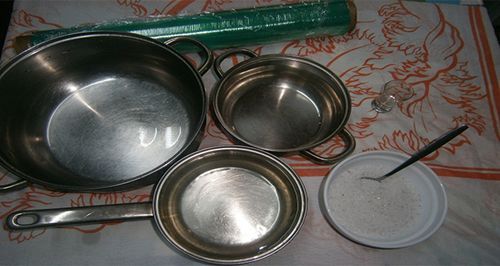
Step One: Salting the Water
This step speaks for itself. Grab your mixing bowl, and fill it with water; add as much salt as you want. I used unfiltered salt from a salt cave near me and added 4 tablespoons of it into the water.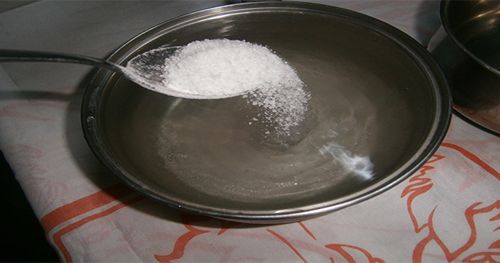
Step Two: Getting Ready for Distillation
Pour the salted water into the large pot, and place the smaller pot inside it. You can see there is still some salt at the bottom.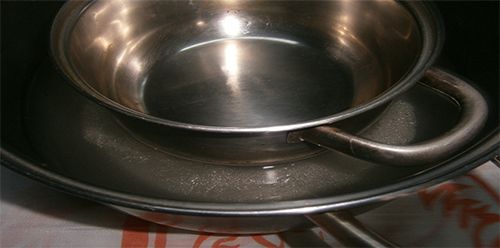 Cover the top with the plastic wrap, and make sure that it’s sealed tightly. You can also use a rubber band to keep the plastic wrap in place. Place the shot glass on top of the plastic wrap right in the middle of the small pot. This will be the spot where all the clean water gathers and falls into the pot.
Cover the top with the plastic wrap, and make sure that it’s sealed tightly. You can also use a rubber band to keep the plastic wrap in place. Place the shot glass on top of the plastic wrap right in the middle of the small pot. This will be the spot where all the clean water gathers and falls into the pot.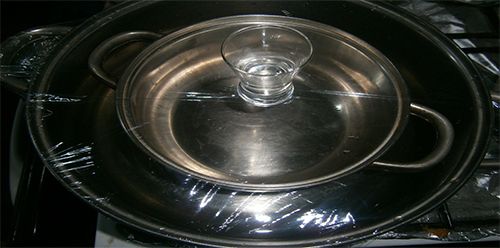
After this, you can start heating up the salted water until it starts to turn into steam and fall into the smaller pot. After about an hour, you should be able to see the water droplets forming on the plastic wrap depending on the strength of your flame.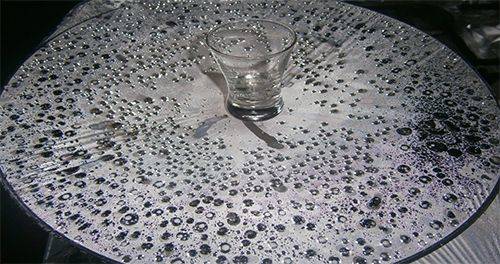
After you have enough water, you can take it off the stove and unwrap it. You should find some water inside the middle pot that is drinkable and clear.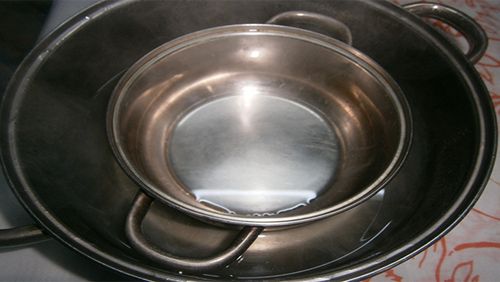
I was left with this dirty, salted water (which I could’ve turned into clear water to the last drop but decided not to for the purpose of demonstration).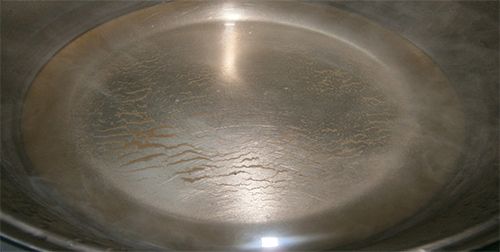
Related: 100-Year-Old Way to Filter Rainwater in a Barrel
Now that you know how easy distillation can be, I will show you how you can make a distiller with a few items:
- A copper pipe and a smaller copper pipe piece (with one end flanged)
- A drill and a drill bit (The drill bit should be the size of the diameter of the copper pipe.)
- A bucket
- A milk can that locks tightly
- A soldering iron and solder
- A flat-faced screw and a wrench that fits it
- A flare nut and a wrench that fits it
- A piece of leather or anything else that will stop the water from escaping
- Tape
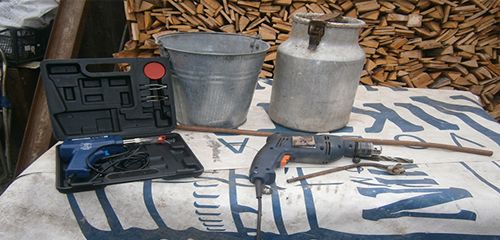 Step One: Creating the Water Cooler
Step One: Creating the Water Cooler
First, start off by making a hole at the bottom of the bucket. This will be where your clean water will dribble out. I also did the same with the lid of the milk can and sealed it with a drill bit that was the size of my smaller copper pipe.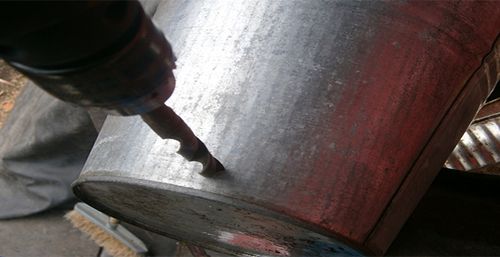
After that, grab the copper piping, and bend it into a something that resembles a spring.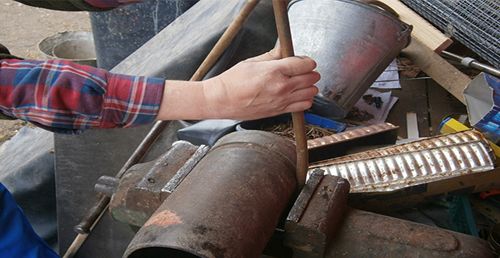
I used an old tank shell that I found at my grandparents’ house.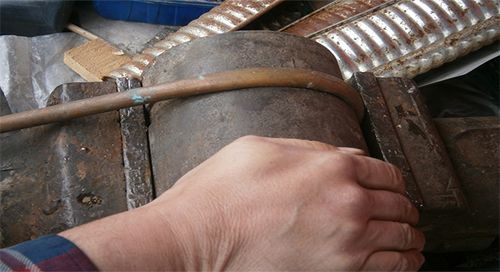
To make sure you don’t break the pipe while bending it, you can fill it with sand or dirt and plug both ends. This will prevent any possible breakage that could happen.
Bend one side straight so it can come out of the hole you just made in the bucket. Do the same with the top half of it, but bend it the opposite way of the hole so it will point away from it.
After that, I started soldering it onto the bucket to make it permanent. I first did the inside then the outside.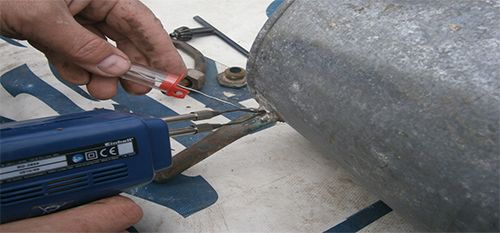
Step Two: Connecting Everything
First, put the flat-faced screw through the head of the milk can and place the leather on top.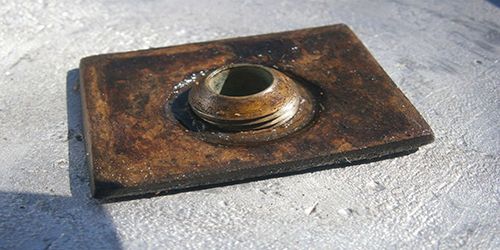
After that, grab the small copper pipe and bend it into a J shape.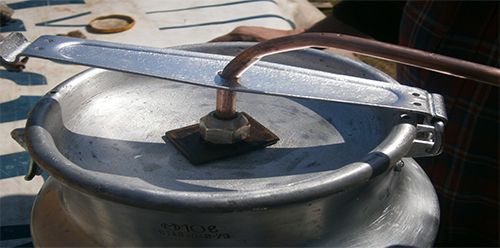
Push the flare nut through the piping, and then push the pipe through the milk can’s seal. You are ready to finish it up. Hold onto the flare nut with a wrench, and start twisting the flat-faced screw with another wrench.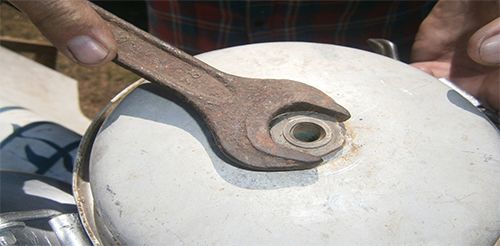
Do the same for the flare nut but in reverse. You are now ready to connect the two parts together.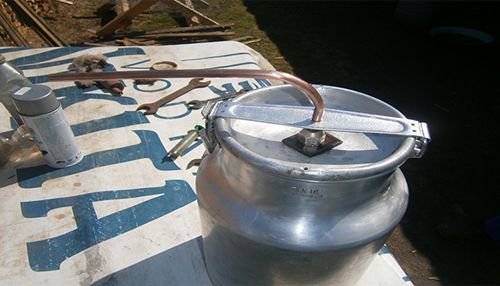
Wrap the outside of the smaller pipe until it locks tightly with the copper piping. Make sure they are a tight fit so no water can escape. Cover it with tape to finish the job. And now you can try it out.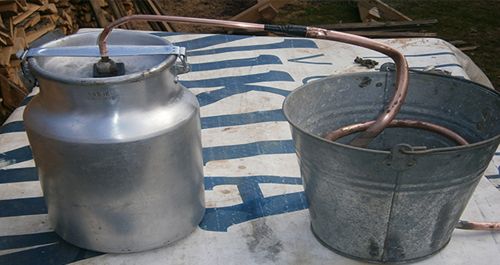
Related: 5 Water Storage Myths
Step Three: Testing Your Distiller
First I grabbed a pot that I used for mixing the salted water. (You can mix it in the milk can too.)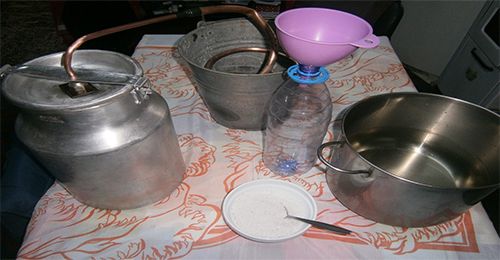 After that, I filled it with water and started to add the unfiltered salt from a salt cave near my home until I felt it was enough.
After that, I filled it with water and started to add the unfiltered salt from a salt cave near my home until I felt it was enough.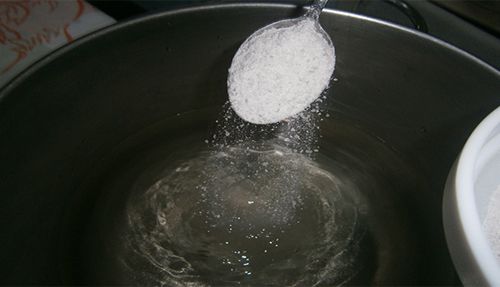
Pour the water in the milk can, and place it on the stove to heat up. While that’s happening, fill the bucket with cold water. (Adding ice to the water will help with the process.)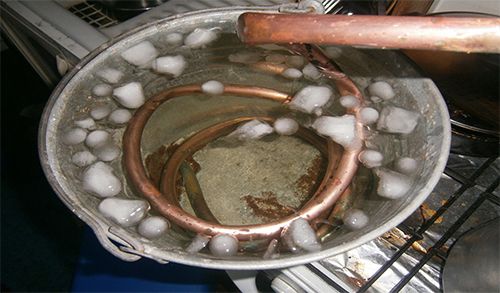
Put down something that will catch your clean water under the end of the copper tube. I used a bottle and a funnel to catch it. After that, wait for roughly 45 minutes, and the water inside the milk can will start to condense. 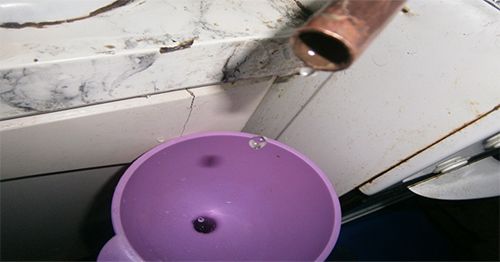
The water inside the milk can will evaporate through tubing, leaving the salt in the tank and turning back into water from the coldness of the copper piping. It goes down the pipe until it reaches the end. After that, you’ll have yourself some clear, drinkable, and tasty water.
You may also like:
Building The Three Bucket Bio-Water-Filter
World’s Smallest Battery Powers House For 2 Days (Video)
How to Adjust the pH in Soil and Water for Abundant Harvests

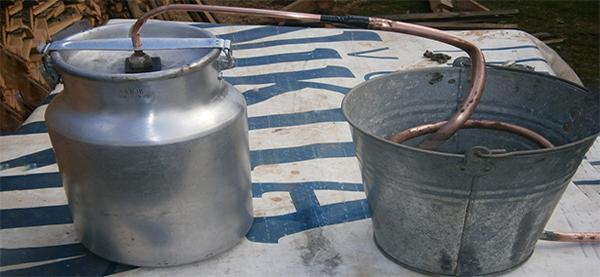














It would probably be a good idea to not use aluminum in making your still. Stainless steel or copper should be fine.
Also, I don’t see that you need to be so overly concerned about sealing the cooking pot, as the steam is constantly escaping, and it should not build up pressure. Now, if you are distilling something more valuable than water it might be a concern. lol
I agree. If you are going to be distilling salt water, stainless steel will resist the salt better than aluminum.
If the pot is sealed, pressure will build up and your steam will reach boiling point faster than in an leaking system. You will distill more water with less fuel usage using a system that doesn’t leak steam. You do need to monitor this system to insure that it doesn’t run dry. You will warp your kettle and perhaps even melt it. This is a batch system. A better alternative, in my opinion, is to make a system where you can add water to the kettle without taking the lid off. That way you can make it a continuously operating system and generate more distilled water.
No matter what the heat source may be, any escaping vapor is lost water, money,time,waste of energy.
That is the reason we use insulation to keep heat or conditioned air in our homes.
Use only stainless steel , Too much copper is very bad for one’s health , distilled water is often called hungry water and will dissolve the copper pipe over time.
Distilled water,or spring water right out of the ground is low on Oxygen.
just add oxygen to the water/air, and it will be fine.
Oxygen poor water will pull oxygen from anything around it, including your body.
Grab an old pressure cooker… Use stainless fittings and stainless tubing… Pressure relief valve hole is used for
fitting (lid to condensing coil…) Only fill to 3/4 capacity
of pot… IF ATTENDED.!.!.! 13 TO 15 gallons per 24 hour
period… Note.!.!.! Keep temp down so as not to cook off
Hg, Mercury… Study up on a devise known as a Retort…
Note.!.!.! Distilling removes important minerals…
Potassium, Magnesium, ect…
Note:.!.!.! When you drink… Have some food in your stomach… DISTILLING DOES NOT REMOVE PETROLEUM
DISTILLATES FROM YOUR H20… I HOPE YOU NEVER
NEED TO USE THIS INFORMATION… GOD BLESS…
woof woof to the bootleg distiller info…
just for educational purposes, of course… wink… wink. 🙂
lol!
here’s a question for anyone. in a shtf scenario, you may only have long-term access to urine. how to distill that into potable water–like on subs. would be a great thing to know if you have animals that produce copious amounts (ie cattle) let alone the family. at the very least, it can be given back to the animals/garden.
If you are going to distill urine, then be sure to do it immediately. Urine is sterile when it comes out of the body, barring infection in the source, but turns bad very quickly.
Submarines do not turn urine into drinkable water I was stationed on them.
No reason that this will not work with urine. Give it a try and tell us how it comes out !!
i was hoping someone (else) would take up the challenge! i don’t have a distiller nor the means to make one, even on a whim. my family don’t support my minimal prep efforts, and this is way beyond their comfort zone, but i would like to know nonetheless. thanks.
also, dp, although it is true that urine collected directly from the body (most easily collected from family), if you are boiling/distilling it, my hope/guess is that this process should take care of most, if not all, nasties you could reasonably expect swimming is urine. i believe, but have not researched enough to be certain, but the ammonia in the urine would distill with the water, so how would this be separated? i don’t know if leaving the water uncovered would allow the ammonia to then evaporate, or if this is a different distillation, or what. which is why if anyone knows how it’s done on submarines, would they share with us how it’s done.
I don’t know where you get your information that urine is distilled aboard a submarine. Why would they do that when they are surrounded by ocean water?
Urine distillation would only be necessary in places like the international space station.(ISS)
As far as the distillation of urine goes, I would personally not drink recycled urine if there is another source of water. Distillation would remove the salts and likely make it suitable for watering plants.
I understand that it was an unlikely scenario question, so if you are interested in this for educational purposes, then I suggest looking into how it is done aboard the ISS. Most likely steam distillation at a specific temp, combined with some serious filtering including activated charcoal to remove nasty tastes and smells.
No offense intended, but If your only option is drinking urine, then you have not done your preps correctly.
Consider filtering the distilled product using a resin filter used for water softeners. In a slightly acidic distillate ( <ph 7) a resin filter should take care of the ammonium ions. That process implies a lot more work than finding a suitable rainwater catchment, stream or pond to distill.
Diane: According to Wikipedia, ammonia can be distilled out of water by boiling. The ammonia you buy for household use is about 30%. The other 70% is water. Typically, and once I looked it up, I remembered, industrial ammonia is called anhydrous ammonia and is shipped under pressure, otherwise it boils off at a fairly low temperature. I had a blueprint machine that used dilute ammonia as a developer for the blueprint. Just the fumes from the paper when it was fresh out of the machine were enough to drive you from the small room where we had the machine. I don’t know the amounts of ammonia in urine, but I suspect they are quite minimal. Distilling will drive off the ammonia before the water turns to vapor. Distilling really is the safest way to produce drinking water.
Some folks will tell you that distilling drives off all the minerals that one needs in one’s daily diet. While I am certainly no chemist, biologist, dietician, so that I have no specialized knowledge from studying the topic, from my reading of various sources, we don’t really get our daily minerals and vitamins from our drinking water. We get them from the foods we eat, so the story about distilled water being bad for you because it lacks minerals is an urban legend.
I may get flamed by someone who claims that a study by “scientists” in Warsaw found that drinking distilled water leads to XYZ deficiency that results in RST disease. I always take claims of scientific studies done by unnamed “scientists” whose specialties remain a mystery and where the “study” was published and reviewed by what group also remains a mystery with a large double handful of salt. Of course, you are totally free to reject what I have said as baseless but I would point out if you are in such dire straits that you need to distill your urine to stay alive, a mineral deficiency would be low on your list of concerns.
If you are in Zzyyxx, California and all you have is urine from your group, distilling it and drinking it may well save your life. The sun is hot enough in Zzyyxx in the summer time that you won’t have to heat the urine, using the pot distillation method should distill your output in a single day.
Left Coast Chuck – I am always impressed with your common sense approach to these issues.
I would have to agree that in my studies of the subject, and I am no “expert” either, that while distilled water will leach some minerals from the human body – it also leached trash and contaminants.
We get our minerals from plants, which take up chemical minerals, and transform them into a bio-available form which we can assimilate. Raw mineral calcium will simply deposit as bone spurs, arthritis, and in other harmful ways, but calcium from spinach, dandelion, and other plants is assimilated and used properly.
This is not to say that distilled water is good for you. Good water goes through a full cycle process, as described by Viktor Schauberger:
https://www.youtube.com/watch?v=bdynEiXFypA
Basically, distilled water is not great, but it will keep you alive, and is no where near the poison that some talking heads will claim that it is… as long as you have a decent food supply with bio-available minerals.
Boil off the low temperature poisons and discard, save the good water, and discard the trash at the end. It is just the same as any other distillation process.
I forgot to add that rain water is distilled water. No one is claiming that drinking clean rain water is poison.
No rainwater is not distilled water otherwise why do we have acid rain?
we are sad as there are no good ideas anywhere and we are very very stuck. PLEASE HELP US! ANYONE!
dawg,
If you are talking about prepping ideas, then this site is a goldmine – all you have to do is read the articles and the comments.
If you are looking for someone to actually come to you, and set up your systems for you, then I am sure that any number of people including myself will be glad to do that… all it takes is $$$$.
dp, dp. of course drinking urine is not anyone’s first option. i have no information about the way waste water is recycled on submarines–which was my original question. didn’t think of a space station. obviously, recycling/distilling urine is the first choice over drinking it straight from the source, and i’d rather give it to the plants too, if there were another reliable source available daily. i do collect rainwater, but it doesn’t precipitate every day. i simply wanted to know if you could downsize a waste water reclamation/distillation process such as is used on subs (and now space stations). i take no offense, but am slightly annoyed, about your last comment, though. i live about 20 miles
from a freshwater lake, but there are lots of others closer who might not give me access in a shtf scenario. when it rains here, there are lots of standing mud puddles, but also a lot of heavy city traffic, so i am equally hesitant about reclaiming that polluted water. on another article about dealing with waste during the same scenario, i considered collecting urine (family) to “force” solid waste down the toilet at the end of the day, but again if there were another source of water to use for this (ie polluted rainwater) i’d still collect/recycle urine if possible, if only for plants. i think it is still the cleaner source. i simply am considering all sources of available water nearby, and none is as close than your own body.
Submarines typically use a distilling operation to convert seawater to fresh water. Yachts and shoreside installations often use reverse osmosis at high (4500+ psi) pressure to process seawater. There is no need to reprocess urine on a submarine … the ocean has enough water in it.
Diane …. quick thought … are you in a position to collect and store rainwater? If so, that might be your best option – if kept clean … drinkable right from the sky; as long as it doesn’t contact any contaminated surfaces before you harvest it.
If you are collecting rain water that has fallen on your roof, it must be cleaned and purified. Have you ever noticed how many birds sit on the peak of your roof? Sometime when it hasn’t rained for a week or so climb up on your roof and take a look at how many presents the birds have left. Careful, don’t fall off. Many major home accidents are homeowners falling from the roof, especially us older guys. Waddaya mean I can’t get on the roof? I’m as spry as I ever was — just before doing a 1 1/2 double summersaulting dive off the edge of the roof.
Use a first flush device to sort the first water runoff and eliminate most of the bugs and bird doo. There are simple designs on the web. Mine uses 8 feet of 3″ PVC with a simple floating ball stop at the top. It holds about 3 gallons and can be drained if necessary to refill and divert another 3 gallons. Total cost was about $20.
Agreed, just use a flush device to flush the trash. This can be done with a simple bucket against a counterweight device operating a valve.
Then run the water into a sand filter. These use graded sand which forms a pollutant eating algae that grows naturally on top of the sand to eat the pollutants.
This whole system requires no energy, but just research and planning. Finish off with an activated charcoal filter, and you have clean, tasty water even from a shingle roof. It would be better to have a planned non-shingle roof. (metal, ceramic, or plastic sheet)
No question or suggestion is stupid, as it gets the conversation started in many cases…
I also understand that many people to this blog are newbies with funny preconceptions, but the information is already out there if you do some diligent research.
basic thing is a dehumidifier is what he is making…. takes water from the air…. same thing….
A dehumidifier uses a different principle …. condensing air on a cold(er) surface. A distiller vaporizes water then condenses the vapor in a condenser or heat exchanger.
Farmer,
I agree 100% as to the mechanical differences between the two systems, but in practice the moisture in the air has already been evaporated from another source, so the dehumidifier is basically the second stage in the distillation process.
Actual distillation is a much cleaner system, obviously, due to all of the dust and other trash floating around in the air. I personally wouldn’t drink water straight from a dehumidifier, but it is a source of treatable water.
Nuclear Submarines distill seawater using a continuous process with the same physicals outlined above with the cooper coil. Heat source can be electrical heater or steam (two different sets of hardware—one and a backup) and cooling heat sink for condensation of the steam into distilled water is usually a seawater heat exchanger. US submarines (including the old diesel boats) do not recycle urine.
OK, I’m sorry. I didn’t mean to offend you, but submarines just jettison the urine and other black water. They get their clean water from the ocean.
If you want to recycle pee, then just dig a hole and pee in the hole all night/day. At the start of the day use the hole as a site for the usual solar condensation method of pulling water from the ground.
IE: plastic over the hole, pot in the middle of the hole under the plastic with a rock on the plastic over the pot to drip the condensate into the pot. Drinkable, although maybe not palatable.
Here is my suggestion for your situation:
Use food grade/safe plastic barrels to hold potable water 200 gallons+. Total cost $100
Use a rainwater collection system to keep the barrels full, and only use the collected water for drinking or cooking.
Use other sources for other uses.
Even rain water is not clean anymore, so filter it using a sediment/sand/active mold barrel for that purpose.
I can get more in depth if you want, but this is all available on the internet… I just do my homework. I’m not some genius.
Think of it this way:
Water. Dirty water in… (rain/river/puddles/whatever) make it clean.
Dirty water out. Two classes: black water, and gray water.
Black water: contains shit and piss. Clean it up best as possible, and get rid of it. Septic, or whatever. Don’t dump it in a stream or in surface water… respect your neighbors.
Grey water: Dish/shower/cooking waste water. Clean it up and reuse it. This is water that you can clean and drink in a pinch, feed to livestock, water the garden, etc.
This will take care of your personal needs in a SHTF situation.
Better to cultivate the friendship of your neighbors with lake access. Why worry about them being possible enemies, when you can have certified friends that have water access?
Work closely with your neighbors to build a small local community. Work WITH them. They are not your enemy. Don’t be paranoid about people – that is not justified. Be paranoid about the government – that is a historical fact.
May God bless you, and yours, my sister.
Interesting discussion! Water is all around us even in the desert. All is needed is some basic knowledge and where to locate the water. A simple continuous still can be made using a sheet of plastic, a small container and a small stone. Dig a hole in the ground below were the soil is damp, Place the container in the center of the hole, cover with the sheet of plastic and weight down the edge and then place the small stone in the center of the plastic. the moisture in the soil evaporates and condenses on the plastic sheet and runs downward to the center and then drips into the container at the bottom of the hole.
If you are around trees… put a plastic bag over a leafy branch and tie the top shut. position the bag so that one corner is lower than the rest of the bag. moisture is given off from the leaves and is collected inside the bag and runs to the lowest spot. don’t leave the bag on the branch more than a few hours or it will damage it.
God bless
As far as drinking pee, the city of San Diego has been processing sewage water for human consumption for some time now. That is water that includes everything you put down the drain in your house and Tony’s Garage down at the stoplight.
As you can tell from my nom de plume, I, unfortunately, am also from the PDRK. The rains that fell this past winter although they were a big help for the rest of the state, did not do much for some cities around the state that depend on wells and underground aquifers for their water supply. Despite having something like 3X the usual rainfall in the PDRK, not much filtered down into the aquifers. As a consequence, after wringing their hands and running around like headless chickens, the dodos who run the town are finally considering recycling sewage to supplement what we get from the city wells. Only one small problem — large quantities of cash. So we will float bond issues knowing that it will take 500 years to pay them off. However, at some period in the future we will be drinking whatever.
Please don’t count on solar distillation as a reliable source of water. Examine carefully how much water solar distillation produces on a sunlit day and how much water one is reputed to need on a daily basis for drinking purposes only. Multiply that by the number of folks you are charged with supporting with water and you will see that you’re going to come up short.
I know, I know, all the “survival manuals” talk about solar stills. They used to put them in life boats. They don’t any more, they put hand powered reverse osmosis purifiers in lifeboats these days. That should tell you something. Don’t take my word for it. Try it in your backyard. It is my feeling that the folks who espouse solar distillation have never had to exist on it. I posted a similar comment on another website and someone challenged my observation by stating that one could build multiple solar stills. If a solar still will produce at maximum, one quart of water per day, you alone will need four such stills for yourself. For wifey and two kiddies that’s 16 such machines that have to be tended each and every day. There just have to be better ways to obtain potable water.
I’m not shilling for them and have no financial interest in the company, but CHKadels.com is selling ready-made distillers for those folks who have lots of bucks. They have 3 gallon 6 gallon and 10 gallon distillers for various large sums of money. All you have to do is provide a heat source and the ingredients. They are suitable for distilling water and other potable beverages. They look like the pictures you have seen of moonshine distillers out in the woods of some Appalachian state. Or, you could do it yourself following the instructions above if you are handy.
Chuck … CHKadels.com has some pretty stills at some pretty prices. A distiller is not hard to construct using a substantial stainless boiler (eBay) and a homemade condenser using copper tubing, a five gallon bucket, and a couple of uniseals. My biggest expense was the “milk can” boiler at about $150. It’s a 1mm thick SS can with silicone seals and a clamp down top. I run it on a propane turkey fryer burner. Food grade silicone tubing is cheap online – used to connect the boiler to the condensing coil.
California needs a real armed uprising by people like you to restore our republic and the bill of rights over there…
public hangings are in order…
I’m just saying, LCC… You already know that I love you, and that I don’t mean any harm…
What is the purpose of adding salt, and where would anyone find a milk can now days? No need to add salt and a pressure cooker would work is place of a milk can.
The purpose of adding salt is to test the distiller. Many pressure cookers are made of aluminum. You really need to stick with stainless steel or possibly copper for the pot regardless of what kind of container it is.
If you make the outlet side of your distillation coil long enough, you can bend it up and over the top of your coolant bucket. This will eliminate the need for soldering and, at the same time, save resources by allowing the bucket to be used for other purposes when not distilling water [or other vital liquids 😉 ].
You are trying to remove all chemicals from the water by distilling, so why would you want to add additions chemicals to the water, IE Salt, not needed or wanted and definitely not needed.
Should not use aluminum for this. In my own humble opinion, aluminum isn’t fit to use for anything that you intend to put in your body.